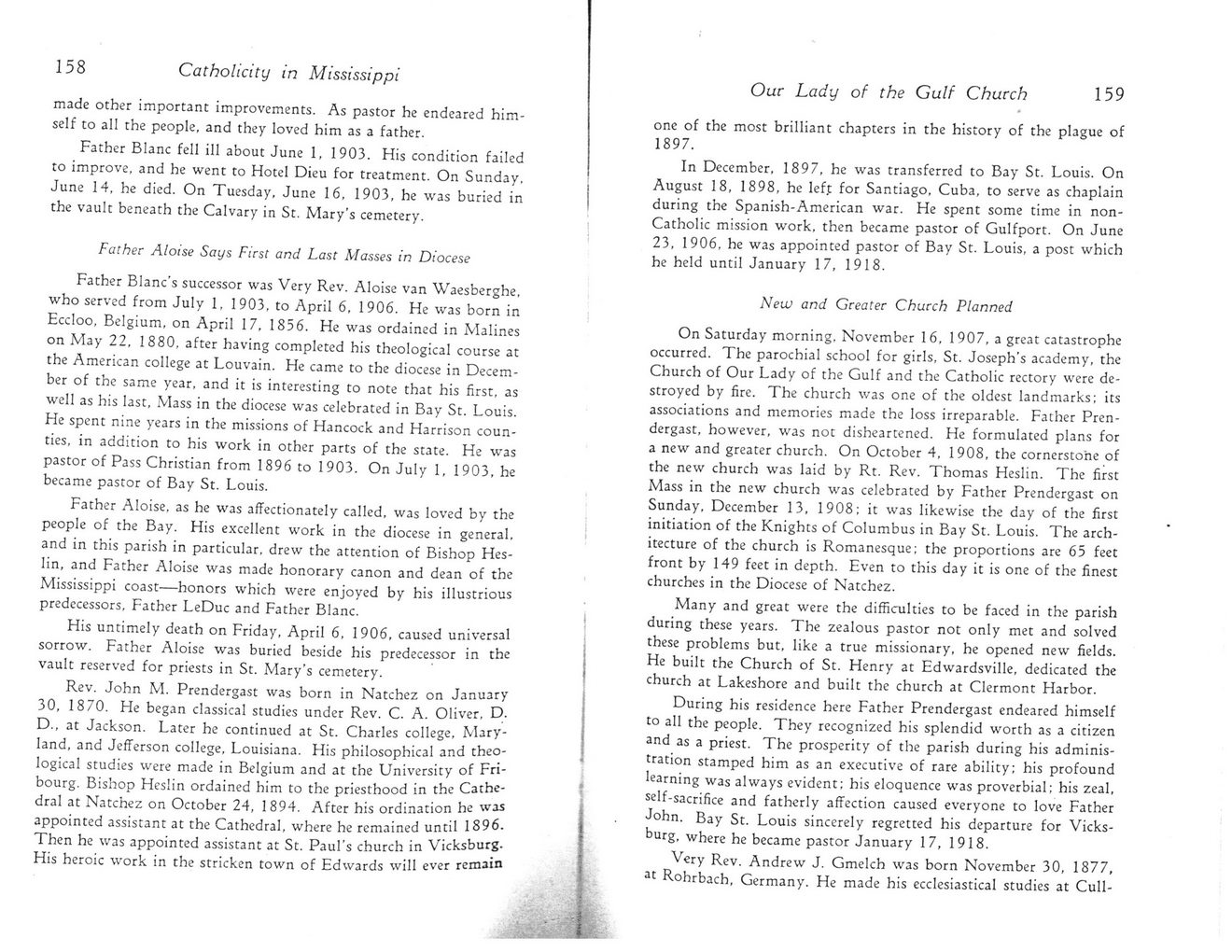This text was obtained via automated optical character recognition.
It has not been edited and may therefore contain several errors.
158 Catholicity tn Mississippi made other important improvements. As pastor he endeared himself to all the people, and they loved him as a father. Father Blanc fell ill about June 1, 1903. His condition failed to improve, and he went to Hotel Dieu for treatment. On Sunday, June 14, he died. On Tuesday, June 16, 1903, he was buried in the vault beneath the Calvary in St. Mary’s cemetery. Father Aloise Says First and Last Masses in Diocese Father Blanc’s successor was Very Rev. Aloise van Waesberghe, who served from July 1, 1903, to April 6, 1906. He was born in Eccloo, Belgium, on April 17, 1856. He was ordained in Malines on May 22, 1880, after having completed his theological course at the American college at Louvain. He came to the diocese in December of the same year, and it is interesting to note that his first, as well as his last, Mass in the diocese was celebrated in Bay St. Louis. He spent nine years in the missions of Hancock and Harrison counties, in addition to his work in other parts of the state. He was pastor of Pass Christian from 1896 to 1903. On July 1, 1903, he became pastor of Bay St. Louis. Father Aloise, as he was affectionately called, was loved by the people of the Bay. His excellent work in the diocese in general, and in this parish in particular, drew the attention of Bishop Hes-lin, and Father Aloise was made honorary canon and dean of the Mississippi coast—honors which were enjoyed by his illustrious predecessors. Father LeDuc and Father Blanc. His untimely death on Friday, April 6, 1906, caused universal sorrow. Father Aloise was buried beside his predecessor in the vault reserved for priests in St. Mary’s cemetery. Rev. John M. Prendergast was born in Natchez on January 30, 1870. He began classical studies under Rev. C. A. Oliver, D. D., at Jackson. Later he continued at St. Charles college, Maryland, and Jefferson college, Louisiana. His philosophical and theological studies were made in Belgium and at the University of Fribourg. Bishop Heslin ordained him to the priesthood in the Cathedral at Natchez on October 24, 1894. After his ordination he was appointed assistant at the Cathedral, where he remained until 1896. Then he was appointed assistant at St. Paul’s church in Vicksburg. His heroic work in the stricken town of Edwards will ever remain Our Lady of the Gulf Church 159 one of the most brilliant chapters in the history of the plague of 1897. In December, 1897, he was transferred to Bay St. Louis. On August 18, 1898, he lef.t for Santiago, Cuba, to serve as chaplain during the Spanish-American war. He spent some time in non-Catholic mission work, then became pastor of Gulfport. On June 23, 1906, he was appointed pastor of Bay St. Louis, a post which he held until January 17, 1918. New and Greater Church Planned On Saturday morning, November 16, 1907, a great catastrophe occurred. The parochial school for girls, St. Joseph’s academy, the Church of Our Lady of the Gulf and the Catholic rectory were destroyed by fire. The church was one of the oldest landmarks; its associations and memories made the loss irreparable. Father Prendergast, however, was not disheartened. He formulated plans for a new and greater church. On October 4, 1908, the cornerstone of the new church was laid by Rt. Rev. Thomas Heslin. The first Mass in the new church was celebrated by Father Prendergast on Sunday, December 13, 1908; it was likewise the day of the first initiation of the Knights of Columbus in Bay St. Louis. The architecture of the church is Romanesque; the proportions are 65 feet front by 149 feet in depth. Even to this day it is one of the finest churches in the Diocese of Natchez. Many and great were the difficulties to be faced in the parish during these years. The zealous pastor not only met and solved these problems but, like a true missionary, he opened new fields. He built the Church of St. Henry at Edwardsville, dedicated the church at Lakeshore and built the church at Clermont Harbor. During his residence here Father Prendergast endeared himself to all the people. They recognized his splendid worth as a citizen and as a priest. The prosperity of the parish during his administration stamped him as an executive of rare ability; his profound learning was always evident; his eloquence was proverbial; his zeal, self-sacrifice and fatherly affection caused everyone to love Father John. Bay St. Louis sincerely regretted his departure for Vicksburg, where he became pastor January 17, 1918. Very Rev. Andrew J. Gmelch was born November 30, 1877, at Rohrbach, Germany. He made his ecclesiastical studies at Cull-

Our Lady of the Gulf Church Document (066)